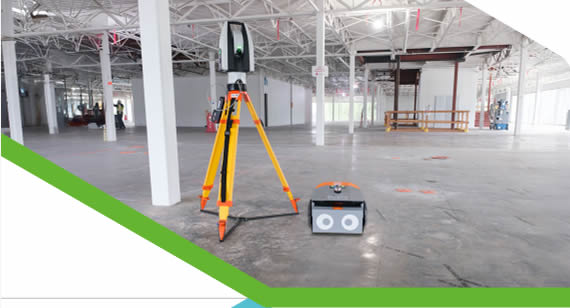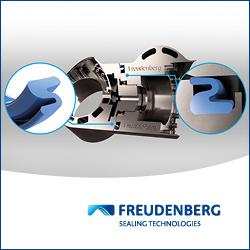By combining our manufacturing-grade measurement systems with Dusty's robotics expertise, we created a solution that delivers 10× faster layouts and sub-millimeter accuracy, reshaping what's possible on construction sites.
Precision Measurement Technology Combined With Autonomous Robots
Q&A with Chris Jundt, Product Sales Manager - Trackers, North America | Hexagon
Tell us a little about Hexagon Manufacturing Intelligence.
Hexagon Manufacturing Intelligence is a global leader in precision measurement and digital reality solutions. Our technologies give industries, from manufacturing and construction to mining and autonomous systems, the confidence to build, navigate, and innovate with precision and sustainability. We bridge the gap between the physical and digital worlds, providing measurement systems that enable smarter decisions and higher quality outcomes at every stage of production and construction. With roughly 24,800 employees in 50 countries and annual net sales of €5.4 billion, Hexagon delivers tools that ensure productivity, quality, and sustainability everywhere from microns to Mars.
Tell us about the partnership with Dusty Robotics and what brought the companies together.
Dusty Robotics set out to revolutionize the construction industry through automation. Specifically, by automating the layout process traditionally done by hand with chalk lines and tape measures. They envisioned a robot capable of printing BIM layouts directly onto construction floors with millimeter-level accuracy, but early attempts in the industry fell short of the precision required. Their search for a solution led them beyond typical construction technology and into the world of metrology. That’s where Hexagon came in. Our Leica Absolute Tracker AT930 offered the accuracy and reliability Dusty needed, 50 times more precise than the minimum standard for their positioning process. By combining our manufacturing-grade measurement systems with Dusty’s robotics expertise, we created a solution that delivers 10× faster layouts and sub-millimeter accuracy, reshaping what’s possible on construction sites.

Hexagon’s precision measurement tools are rooted in manufacturing, so what convinced your team that they could be adapted successfully to the dynamic and unpredictable environment of construction sites?
At Hexagon, we’ve always believed precision shouldn’t be limited to the factory floor. When Dusty approached us, we saw a chance to extend our technology’s impact to an entirely new environment, one defined by unpredictability. The fundamental principles of precision measurement don’t change whether you’re measuring an automotive door panel or aligning large Aerospace structures; it’s about accuracy, repeatability, and reliability. We knew that by adapting our Leica Absolute Tracker platform, designed for high-performance industrial metrology, to withstand temperature changes, moisture, and varying lighting conditions, we could bring the same trusted precision to construction. The key was collaboration: Dusty Robotics’ deep understanding of field operations paired with our metrology expertise allowed us to engineer a solution robust enough for real-world job sites.
What were the biggest technical or environmental challenges Hexagon had to overcome to make the Leica Absolute Trackers work reliably in construction settings?
Construction environments are inherently harsh with dust, vibration, lighting changes, and wide temperature swings. Our biggest challenge was enhancing our metrology-grade laser tracker to be even more reliable in those field conditions. To achieve that, we enhanced sealing and thermal stability, optimized tracking algorithms for dynamic movement, and collaborated closely with Dusty to integrate real-time feature packs that improved performance on moving robots. The new Leica AT500 advances that even further. Its IP54-rated durability protects against dust and moisture, while its controller-less design, hot-swappable batteries, and automatic PowerLock system ensure uninterrupted tracking, even when the robot briefly moves out of view.
.jpg)
This partnership essentially created an entirely new category: automated construction layout. How has the industry responded so far? Any feedback from customers?
The response has been tremendous. Together, we’ve helped Dusty Robotics establish automated layout as a new standard for jobsite execution. Their system, powered by our Leica Absolute Trackers, has already printed layouts for more than 200 million square feet of construction projects. Contractors are seeing measurable results: layout times reduced from weeks or months to days, accuracy within 1/16 inch, and major reductions in costly rework. In one California hospital project, the solution saved three months on the schedule and millions in potential rework costs. We’re also hearing strong feedback from field teams who say the system reduces pressure on an already overstretched workforce by automating repetitive layout tasks and letting skilled trades focus on higher-value work.
Looking ahead, how do you see the integration of the newer Leica AT500 changing the user experience and capabilities for contractors in the field?
The Leica AT500 represents the next evolution of this collaboration. It brings enhanced mobility and simplicity to the jobsite while having fewer components, faster setup, and reduced warm-up time. For contractors, this means less time managing equipment and more time focused on value-added work. With its battery-powered design and long-range 320 m volume, the AT500 delivers unprecedented portability and coverage. It also enables Dusty’s FieldPrinter 2 to capture floor-flatness and levelness data in real time, turning layout robots into broader quality-control tools. Ultimately, this isn’t just about faster layout, it’s about connecting the digital model directly to the physical build environment, ensuring design intent is executed flawlessly in the field. The AT500 doesn’t just measure, it empowers construction teams to build with confidence.
Chris Jundt is the Product Sales Manager for our Laser Trackers and PRESTO Automation Inspection Cells for North America. Prior to Chris’ current role, he was a Key Account Manager for Hexagon focused on supporting the Aerospace Structures Industry Segment and Hexagon’s Product Families, including Laser Tracker Systems, Portable Measuring Arms, White Light Scanning Systems, and Automated Solutions. His career in Metrology started in 1996, immediately after having graduated from South Dakota School of Mines and Technology with a Bachelor of Science degree in Industrial Engineering. His career path has included end-user roles as Customer Quality Engineer, Measurement Quality Engineer, Quality Engineering Supervisor, and Metrology OEM roles as Applications Engineer, Sales Engineer, District Sales Manager, Regional Sales Manager, Key Account Manager, and now Product Sales Manager. Chris joined Hexagon in 2007.
The content & opinions in this article are the author’s and do not necessarily represent the views of RoboticsTomorrow
Featured Product

